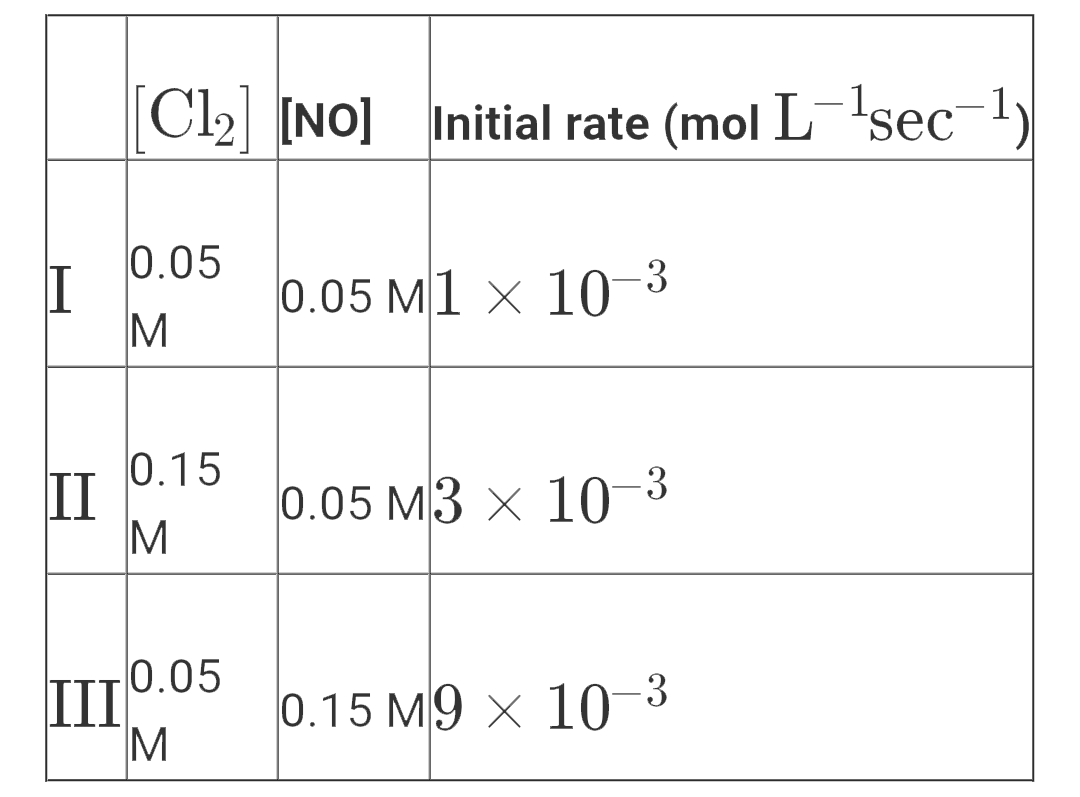Reaction stoichiometry, kinetics and thermodynamics that of Nitrosyl chloride (NOCl), is a yellow gas that is most commonly encountered as a decomposition product of aqua regia. It is toxic and irritating to the lungs. On heating NOCl decomposes as
2NOCl→2NO+Cl2.
The enthalpy change (ΔH) for the formation of 1 mole of Cl2 by the decomposition of NOCl is 75.3KJ between 100.Kto600K. The standard entropies (S∘_(298K)) of different species are as given below:
SubstanceNOClNOCl2S∘298K264211223
Calculate G of the above decomposition reaction at 298K.
To calculate the Gibbs free energy change (ΔG) for the decomposition of nitrosyl chloride (NOCl) at 298 K, we will follow these steps:
Step 1: Write the Reaction
The decomposition reaction of nitrosyl chloride is given as:
2NOCl→2NO+Cl2
Step 2: Identify Given Values
- Enthalpy change (ΔH) for the reaction: 75.3kJ (which is 75,300J)
- Standard entropies at 298 K:
- S∘(NOCl)=264J/K
- S∘(NO)=211J/K
- S∘(Cl2)=223J/K
Step 3: Calculate Standard Entropy Change (ΔS)
The standard entropy change for the reaction can be calculated using the formula:
ΔS∘=∑S∘products−∑S∘reactants
Calculating the entropy for products:
- For 2 moles of NO: 2×211J/K=422J/K
- For 1 mole of Cl₂: 223J/K
Total for products:
S∘products=422+223=645J/K
Calculating the entropy for reactants:
- For 2 moles of NOCl: 2×264J/K=528J/K
Now, substituting into the ΔS formula:
ΔS∘=645−528=117J/K
Step 4: Calculate ΔG using the Gibbs Free Energy Equation
The Gibbs free energy change is calculated using the equation:
ΔG=ΔH−TΔS
Substituting the known values:
- ΔH=75,300J
- T=298K
- ΔS=117J/K
Calculating:
ΔG=75,300−(298×117)
ΔG=75,300−34,866
ΔG=40,434J
Step 5: Convert ΔG to kJ
To express ΔG in kilojoules:
ΔG=40,4341000=40.43kJ/mol
Final Answer
Thus, the Gibbs free energy change (ΔG) for the decomposition of nitrosyl chloride at 298 K is:
ΔG=40.43kJ/mol
---
The decomposition reaction of nitrosyl chloride is given as:
2NOCl→2NO+Cl2
- Enthalpy change (ΔH) for the reaction: 75.3kJ (which is 75,300J)
- Standard entropies at 298 K:
- S∘(NOCl)=264J/K
- S∘(NO)=211J/K
- S∘(Cl2)=223J/K
The standard entropy change for the reaction can be calculated using the formula:
ΔS∘=∑S∘products−∑S∘reactants
- For 2 moles of NO: 2×211J/K=422J/K
- For 1 mole of Cl₂: 223J/K
S∘products=422+223=645J/K
- For 2 moles of NOCl: 2×264J/K=528J/K
ΔS∘=645−528=117J/K
The Gibbs free energy change is calculated using the equation:
ΔG=ΔH−TΔS
- ΔH=75,300J
- T=298K
- ΔS=117J/K
ΔG=75,300−(298×117)
ΔG=75,300−34,866
ΔG=40,434J
To express ΔG in kilojoules:
ΔG=40,4341000=40.43kJ/mol
Thus, the Gibbs free energy change (ΔG) for the decomposition of nitrosyl chloride at 298 K is:
ΔG=40.43kJ/mol
Topper's Solved these Questions
- CHEMICAL EQUILIBRIUMBOOK - RESONANCE ENGLISHCHAPTER - CHEMICAL EQUILIBRIUMEXERCISE - Advanced Level Problems (Part-3)(Stage-5)
2 Videos
- CHEMICAL EQUILIBRIUMBOOK - RESONANCE ENGLISHCHAPTER - CHEMICAL EQUILIBRIUMEXERCISE - Advanced Level Problems (Part-3)(Stage-1)
38 Videos
- CHEMICAL BONDINGBOOK - RESONANCE ENGLISHCHAPTER - CHEMICAL BONDINGEXERCISE - ORGANIC CHEMISTRY(Fundamental Concept )
6 Videos
- D & F-BLOCK ELEMENTS & THEIR IMPORTANT COMPOUNDS BOOK - RESONANCE ENGLISHCHAPTER - D & F-BLOCK ELEMENTS & THEIR IMPORTANT COMPOUNDS EXERCISE - Match the column
1 Video
Similar Questions
Reaction stoichiometry, kinetics and thermodynamics that of Nitrosyl chloride (NOCl), is a yellow gas that is most commonly encountered as a decomposition product of aqua regia. It is toxic and irritating to the lungs. On heating NOCl decomposes as
2NOCl→2NO+Cl2.
The enthalpy change (ΔH) for the formation of 1 mole of Cl2 by the decomposition of NOCl is 75.3KJ between 100.Kto600K. The standard entropies (S∘_(298K)) of different species are as given below:
SubstanceNOClNOCl2S∘298K264211223
Calculate the temperature above which the reaction will become non-spontaneous.
View SolutionReaction stoichiometry, kinetics and thermodynamics ltbgt Nitrosyl chloride (NOCl), is a yellow gas that is most commonly encountered as a decomposition product of aqua regia. It is toxic and irritating to the lungs. On heating NOCl decomposes as
2NOCl→2NO+Cl2.
The enthalpy change (ΔH) for the formation of 1 mole of Cl2 by the decomposition of NOCl is 75.3KJ between 100.Kto600K. The standard entropies (S∘_(298K)) of different species are as given below:
SubstanceNOClNOCl2S∘298K264211223
Calculate the temperature at which Kp will be double the value at 298K.
View SolutionThe enthalpy change (ΔH) for the reaction, N2(g)+3H2(g)→2NH3g is −92.38kJ at 298K What is ΔU at 298K?
View SolutionThe enthalpy change (ΔH) for the reaction
N2(g)+3H2(g)→2NH3(g)
is −92.38kJ at 298K. What is ΔU at 298K?
View SolutionThe given data are for the reaction, 2NO(g)+Cl(g)→2NOCl(g) at 298K

The rate law of the reactions is
View SolutionThe enthalpy change (ΔH) for the reaction
N2(g)+3H2(g)→2NH3(g)
is -92.38 kJ at 298 K. What is ΔU at 298 K ? (R=8.314jK−1mol−1)
View SolutionThe internal energy change (ΔU) for the reaction CH4(g)+2O2(g)→CO2(g)+2H2O(l) is −885kJmol−1 at 298K. What is ΔH at 398 K?
View SolutionThe enthalpy change for a given reaction at 298K is −xcalmol−1. If the reaction occurs spontaneously at 298K, the entropy change at that temperature
View SolutionThe standard enthalpy of Br2(g) is taken to be zero at standard conditions of 298K and 1atm.
View SolutionStandard heat of formation at 298K is arbitrarily taken to be zero for
View Solution
